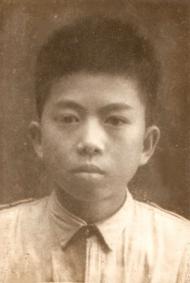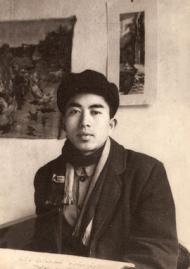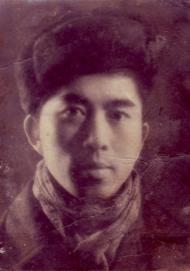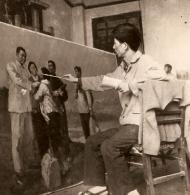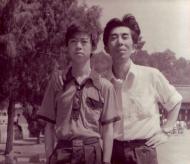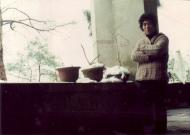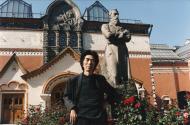1934
Du Yongqiao is born in Dashi Township, Yuechi County.
1951
Du tests into the Chengdu Art Academy Painting Department.
1953
After reforms in the national university system, the Chengdu Art Academy Painting Department and Applied Arts Department are moved to Chongqing and combined with the Southwest People’s Art Academy to form the Southwest Arts Academy (the precursor to the Sichuan Fine Arts Institute). Du Yongqiao continues his studies at the new painting department.
1956
Upon graduation, Du takes up a position on the painting faculty.
His work Performance by Advanced Producers is featured in the First Sichuan Provincial Youth Fine Arts Exhibition (Chengdu), where it wins Second Prize.
1957
The print work By the Brook is featured in the Sixth World Festival of Youth and Students (Moscow), and is collected by a museum in the Soviet Union, and by the National Art Museum of China. The work is published in numerous magazines.
The print work Night and a watercolor painting (title unknown) are featured in the First National Youth Fine Arts Exhibition (Beijing Working People’s Cultural Palace). Night wins Third Prize.
Du is assigned a teaching position at the Sichuan Art Institute Middle School.
Du joins the Sichuan Artists Association.
1958
As part of a campaign sending cadres to the countryside, Du travels to a village in the Nantong mining district of Chongqing, where he falls gravely ill.
Du is temporarily assigned to the Chongqing Municipal Organization Department for six months to take part in the editing work of the periodical Poems and Paintings of Labor.
1961
The watercolor painting Eternal Friendship between China and Poland is featured in the China-Poland Friendship Arts Competition (Polish Embassy, Beijing) where it wins Second Prize.
1962
Du takes his students to the grasslands of Zoige for half a year to experience life.
Du marries Wang Jixiang.
1964
Du’s daughter Du Shuang is born.
1965
Du is assigned to teach at Chongqing No. 29 Middle School for one year.
1966
With the onset of the Cultural Revolution, classes were suspended. His house was searched, and hundreds of his works accumulated over the years were confiscated to be exhibited in the 'Black Painting Exhibition', where they were completely looted
Du separates from his wife.
1967
Du marries Zhou Deyu.
1968
Du's son Du Fangxiao is born.
Du is hospitalized with a grave illness.
1969
Du is sent to the 0022 Brigade Farms in Tongxi Township, Hechuan County, for a year of labor alongside fellow faculty members.
1970
Du returns to Chongqing, and is hospitalized with a grave illness.
The faculty of the Sichuan Art Institute Middle School returns to work. Du is assigned to the Painting and Sculpture Department.
1975
Du leads a group of “worker, peasant and soldier students” to Ziyang Factory 431 for nearly half a year of “open learning.”
Du falls gravely ill.
Du's father Du Maosen passed away.
1976
Du’s mother Ding Yingxiu passed away.
1979
Du is named lecturer.
Du converts to Buddhism at Baoguang Temple in Xindu County.
1980
Du is temporarily assigned to teach at the art academy middle school.
1981
Du joins the China Artists Association.
1984
The oil painting Eternal Years was featured in the exhibition Oil Paintings and Prints from the Sichuan Fine Arts Institute (National Art Museum of China, Beijing), and is part of the collection of the National Art Museum of China.
Du is assigned to the Teacher Training Department.
1987
Du is named an associate professor.
Du divorces Zhou Deyu.
1988
Du Yongqiao marries Zhao Qing.
1989
Du and his wife Zhao Qing move to a mountaintop in Nanshan, Chongqing, to begin a life of seclusion.
1991
Du and Zhao Qing take lay Buddhist vows under Master Qingding of Zhaojue Temple.
1992
Du’s lifetime achievements are recorded in the book History of New Print Art in Sichuan (Sichuan Fine Arts Publishing House).
Du's daughter Du Yimo is born.
1993
Du’s lifetime achievements are recorded in the book China Fine Arts Yearbook 1949–1989 (compiled by the National Art Museum of China, published by Guangxi Fine Arts Publishing House).
Du returns to the school, ending three years of seclusion.
1994
Du visits his childhood home in Yuechi.
1995
Du is named a full professor.
Du retires.
1996
The watercolor painting Still Life is featured in the First China Watercolor Painting Exhibition (Shijiazhuang Municipal Museum), winning a Silver Medal.
The watercolor paintings Grassland and Still Life are featured in the Sichuan Provincial Fine Arts Exhibition (Sichuan Art Museum, Chengdu). Still Life wins a Silver Medal.
1997
Du Yongqiao Art Retrospective is held in Chongqing and Chengdu (Museum of the Sichuan Fine Arts Institute, Sichuan Art Museum). The journal Sichuan Fine Arts (Sichuan Artists Association) publishes Transcript of the Du Yongqiao Art Retrospective Symposium and other texts.
The television program If the Heavens Cared—Du Yongqiao and His Painting airs on China Education Television and Chongqing TV stations 1 and 2.
1998
Du moves to Chengdu.
1999
A series of oil paintings and watercolors are published in the magazine Fine Arts (China Artists Association).
The book Oil Paintings by Du Yongqiao is published by Southwestern Normal University Publishing House.
The book Outstanding Works by Famous Artists: Du Yongqiao’s Still Lifes-Flowers, is published by Sichuan Fine Arts Publishing House.
2000
A series of oil paintings, watercolors and Interview with Du Yongqiao, by Zhang Yingchuan, are published in the magazines Rongbaozhai (Rongbaozhai Press) and Art Observations (Chinese National Academy of the Arts).
The watercolor painting Still Life is included in the book History of Chinese Watercolor Painting (Shanghai Pictorial Publishing House).
The watercolor painting Female Nude is collected in the book Graphic History of Chinese Watercolor Painting (Guangxi Fine Arts Publishing House).
2002
Du joins a group of artists for an observational trip to Russia.
Du travels with his wife Zhao Qing to his hometown of Yuechi, and their former home in Nanshan.
Du converts to Christianity.
2003
Du is baptized.
2004
The book Ten Leading Chinese Artists: Du Yongqiao Painting Album is published (People's Daily Publishing House).
2006
The watercolor painting Herding is featured in the exhibition One Hundred Years of Chinese Watercolor Painting (National Art Museum of China, Beijing) and collected in the catalogue One Hundred Years of Chinese Watercolor Painting 1905–2006 (People's Fine Arts Publishing House).
2007
Du falls gravely ill.
Du Yongqiao Oil and Watercolor Retrospective Exhibition is held (Sichuan Art Museum, Chengdu), and is covered in print and online media across the country.
Du creates his final oil painting, Mourning.
The Du Yongqiao Oil Painting Research Center is established at Sichuan Normal University.
One month after the retrospective exhibition, Du Yongqiao passes away.


